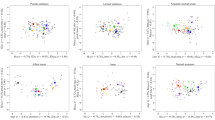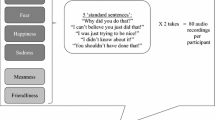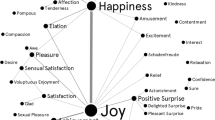Abstract
This study aimed at examining the effects of attachment style on the ability of recognizing emotions, from acoustic stimuli, in subjects with induced emotional states. An adequate sample of 145 university students (71 females and 74 males; mean age = 23.37 ± 2.05) was recruited from the Second University of Naples (Italy). The subjects, classified for attachment style into Secure, Insecure Dismissing, Insecure Preoccupied and Insecure Fearful, were randomly assigned with one of three (sad, fearful or neutral) different elicited emotional conditions induced by viewing short movies. Immediately after the mood-induction procedure, subjects undertook a vocal emotion-decoding task. Secure subjects were more accurate in recognizing surprise and sadness than the Insecure group; Fearfully attached individuals were less accurate in identifying vocal stimuli conveying sadness than the Securely and Dismissively attached groups. The recognition of vocal stimuli was not affected by induced mood conditions. No mood-congruity effects were found. The study sheds light on some of the factors underlying the emotion-recognition process. Possible explanations of the contribution of attachment style on the ability to decode vocal stimuli were discussed.

Similar content being viewed by others
Explore related subjects
Discover the latest articles, news and stories from top researchers in related subjects.References
Plutchik R. Emotions as adaptive reactions: Implications for therapy. Psychoanal Rev 1966;LIII2:105–10.
Harris PL. Individual differences in understanding emotion: The role of attachment status and psychological discourse. Attach Human Dev. 1999;1(3):307–24.
Russell J, Bachorowski JA, Fernandez-Dols JM. Facial and vocal expressions of emotions. Annu Rev Psychol. 2002;54:329–49.
Astington JW, Harris PL, Olson DR, editors. Developing theories of mind. Cambridge: Cambridge University Press; 1988.
Laible JD, Thompson RA. Attachment and emotional understanding in preschool children. Dev Psychol. 1998;34(5):1038–45.
Bowlby J. Maternal care and mental health. Geneva: World Health Organisation; 1951.
Bowlby J. The making and breaking of affectional bonds. London: Tavistock Publications; 1979.
Greenberg M, Cicchetti D, Cummings EM. Attachment in the preschool years: Theory, research and intervention. Chicago: University of Chicago Press; 1990.
Main M, Salomon J. Discovery of a new, insecure-disorganized/disoriented attachment pattern. In: Brazelton TB, editor. Yogman M. Affective Development in Infancy. Norwood N.J.: Ablex; 1986. p. 95–124.
Colle L, Del Giudice M. Patterns of attachment and emotional competence in middle childhood. Soc Dev. 2011;20(1):51–69.
De Rosnay M, Harris PL. Individual differences in children’s understanding of emotion: The roles of attachment and language. Attach Hum Dev. 2002;4(1):39–54.
Steele H, Steele M, Croft C. Early attachment predicts emotion recognition at 6 and 11 years old. Attachment & Hum Dev. 2008;10(4):379–93.
Suslow T, Dannlowski U, Arolt V, Ohrmann P. Adult attachment avoidance and automatic affective response to sad facial expressions. Aust J Psychol. 2010;62(4):181–7.
Niedenthal PM, Braur M, Innes-Ker AH, Robin L. Adult attachment and the perception of facial expression of emotion. J Pers Soc Psychol. 2002;82(3):419–33.
Bouhuys AL, Bloem MG, Groothuis TGG. Induction of depressed and elated mood by music influences the perception of facial emotional expressions in healthy subjects. J Affective Disorders. 1995;33:215–26.
Niedenthal PM, Halberstadt JB, Margolin J, Innes-Ker AH. Emotional state and the detection of change in facial expression of emotion. Eur J Soc Psychol. 2000;30:211–22.
Niedenthal PM, Brauer M, Halberstadt JB, Innes-Ker AH. When did her smile drop? Facial mimicry and the influences of emotional state on the detection of change in emotional expression. Cognition Emotion. 2001;15(6):853–64.
Schmid PC. Schmid Mast M. Mood effects on emotion recognition. Motiv. Emotion. 2010;34:288–92.
McClure EB. A meta-analytic review of sex differences in facial expression processing and their development in infants, children and adolescents. Psycholl Bull. 2000;126:424–53.
Caro DH. Socio-economic status and academic achievement trajectories from childhood to adolescence. Canadian Journal of Education. 2009;32(3):558–90.
Sirin SR. Socioeconomic status and academic achievement: A meta-analytic review of research. Rev Educ Res. 2005;7(3):417–53.
Esposito A, Capuano V, Mekyska J, Faundez-Zanuy M. A Naturalistic Database of Thermal Emotional Facial Expressions and Effects of Induced Emotions on Memory. In Esposito A et al. editors. COST ‘11. Proceedings of the 2011 International Conference on Cognitive Behavioural Systems. 2011 Feb 21-26; Dresden, Germany. Heidelberg: Springer; 2012. p. 158-73.
Bullerjahn C, Güldenring M. An empirical investigation of effects of film music using qualitative content analysis. PsychoMcol. 1994;13(1–2):99–118.
Tan S-L, Spackman MP. Bezdek, Matthew A. Viewers’ interpretation of film characters’ emotions: Effects of showing film music before or after a character is shown. Music Percept. 2007;25(2):135–52.
Ekman P, Friesen WV, Hager JC. The facial action coding system. 2nd ed. Salt Lake City: Weidenfeld & Nicolson; 2002.
Esposito A. The perceptual and cognitive role of visual and auditory channels in conveying emotional information. Cog Comp. 2009;1(2):268–78.
Esposito A, Riviello MT, Di Maio G. The COST 2102 Italian audio and video emotional database. In: Apolloni B, Bassi, S, Morabito CF editors. WIRN 09. Proceedings of the 19th Italian Workshop on Neural Nets; 2009 May 28-30; Vietri sul Mare, Salerno, Italy. Amsterdam: IOS press; 2009. p. 51–61.
Esposito A, Riviello MT. The new Italian audio and video emotional database. In: Esposito A, Campbell N, Vogel C, Hussain A, Nijholt A. editors. COST ‘09. Proceedings of the Second international conference on Development of Multimodal Interfaces: active Listening and Synchrony; 2009 Mar 23-27; Dublin, Ireland. Heidelberg: Springer; 2010. p. 406–22.
Brennan KA, Clark CL. Shaver PR Self report measurement of adult attachment: An integrative overview. In: Simpson JA, Rholes WS, editors. Attachment theory and close relationships. New York: Guilford Press; 1998. p. 46–76.
Picardi A, Bitetti D, Puddu P, Pasquini P. La scala Experiences in Close Relationships (ECL), un nuovo strumento per la valutazione dell’attaccamento negli adulti: Traduzione, adattamento, e validazione della versione italiana. Riv Psichiatr. 2000;3(35):114–20.
Picardi A, Vermigli P, Toni A, D’Amico R, Bitetti D, Pasquini P. Evidence of the validity of the Italian version of the questionnaire “Experiences in Close Relationships” (ECR), a self-report instrument to assess adult attachment. J Psychopathol. 2002;8:282–94.
Barratt W. The Barratt Simplified Measure of Social Status (BSMSS) measuring SES. Unpublished manuscript, Indiana State University 2006. Retrieved from http://wbarratt.indstate.edu/socialclass/Barratt_Simplifed_Measure_of_Social_Status.pdf.
Scherer KR, Banse R, Wallbott HG, Goldbeck T. Vocal cues in emotion encoding and decoding. Motiv Emotion. 1991;15(2):123–48.
Scherer KR. Vocal communication of emotion: A review of research paradigms. Speech Commun. 2003;40(1):227–56.
Thompson WF, Balkwill LL. Decoding speech prosody in five languages. Semiotica. 2006;158:407–24.
Enos F, & Hirschberg J. A framework for eliciting emotional speech: capitalizing on the actor’s process. In: Devillers L, Schuller B, Cowie R, Douglas Cowie E, Batliner A editors. LREC 2006. Proceedings of 1st International Workshop on Emotion: Corpora for Research on Emotion and Affect; 2006 May 23; Genova, Italy. p. 6-10.
Busso C, Bulut M, Lee C, Kazemzadeh A, Mower E, Kim S, Narayanan SS. IEMOCAP: Interactive emotional dyadic motion capture database. LRE. 2008;42(4):335–59.
Seppi D, Batliner A, Schuller B, Steidl S, Vogt T, Wagner J, Devillers L, Vidrascu L, Amir N, Aharonson V. Patterns. Prototypes, Performance: Classifying Emotional User State. Interspeech; 2008. p. 601–4.
Lay KL, Waters E, Posada G, Rideway D. Attachment security, affect regulation, and defensive responses to mood induction. Monogr Soc Res Child. 1995;60(2/3):179–96.
Liotti G. Trauma, dissociation and disorganized attachment: Three strands of a single braid. Psychother Theor Res Pract Train. 2004;41:472–86.
Main M, Parkes CM, Stevenson-Hinde J, Marris P. Attachment across the life cycle. London: Routledge; 1991.
Conklin CZ, Bradley R, Westen D. Affect regulation in borderline personality disorder. J Nerv Ment Dis. 2006;194:69–77.
L’assessment Cionini L. In: Bara BG, editor. Nuovo manuale di psicoterapia cognitiva, vol. III – Patologie. Torino: Bollati Bolinghieri; 2004. p. 15–81.
Crittenden P. Nuove prospettive sull’attaccamento. Milano: Guerini; 1994.
Chepenik LG, Cornew LA, Farah MJ. The influence of sad mood on cognition. Emotion. 2007;7(4):802–11.
Author information
Authors and Affiliations
Corresponding author
Additional information
The names of the authors are in alphabetic order since each made a significant contribution to the research reported.
Appendix: Consent form
Appendix: Consent form
 You are invited to participate in a research study aiming at investigate how individuals get to know each others.
You are invited to participate in a research study aiming at investigate how individuals get to know each others.
In this study, you will be asked to answer a number of questions regarding your preferences, habits and opinions and you will be requested to watch and listen to a series of vocal and visual emotional stimuli.
There are no risks involved. However, you may stop participating at any time, especially if you feel uncomfortable, distressed or inappropriate. Please inform the experimenter and withdraw your participation, in this case. Your data remain anonymous and confidential and you can ask at any time to withdraw your data.
You will be required to do these tasks within 1 week following the signature of this consent form.
When the tasks are done, you will receive a “debrief form” which will describe the reasons we are collecting data on these tasks and your. The experiment takes about 20 min.
Please feel free to interrupt the tasks at any time.
If you agree to participate in this experiment, please sign below
I give the consent to use of my personal data in accordance with local Privacy laws and standards (D.Lgs. 196/2003). 
Rights and permissions
About this article
Cite this article
Esposito, A., Palumbo, D. & Troncone, A. The Influence of the Attachment Style on the Decoding Accuracy of Emotional Vocal Expressions. Cogn Comput 6, 699–707 (2014). https://doi.org/10.1007/s12559-014-9292-x
Received:
Accepted:
Published:
Issue Date:
DOI: https://doi.org/10.1007/s12559-014-9292-x




